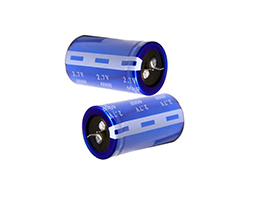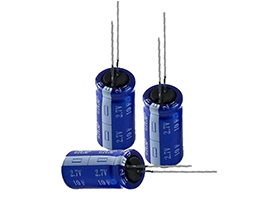Consulting phone:
135-3037-2041
(Mr.Wang)
Farad capacitors are mainly composed of polarized electrodes, collectors, electrolytes, diaphragms, leads and packaging materials. The electrode material, the composition of the electrolyte, the quality of the separator, and the electrode fabrication technique have a decisive influence on the performance of the Farad capacitor.

Farad capacitors are capacitors that use the electric double layer principle . When the applied voltage is applied to the two plates of the Farad capacitor, it is the same as the general capacitor, the positive electrode of the plate stores positive charge, and the negative plate stores negative charge. Opposite charges are formed on the interface between the electrolyte and the electrode to balance the internal electric field of the electrolyte. The positive and negative charges swing between the positive and negative charges on the contact surface between the two different phases. In the opposite orientation, this charge distribution layer is called the electric double layer, so the capacitance is very large. When the potential between the two plates is lower than the oxidation recovery electrode potential of the electrolyte, the charge on the electrolyte interface will not be separated from the electrolyte, and the Farad capacitor is in the normal working condition (generally below 3V). If the voltage across the capacitor exceeds the oxidation of the electrolyte When the electrode potential is restored, the electrolyte will be differentiated, which is an abnormal situation. As the Farad capacitor discharges, the charges on the positive and negative plates are discharged by the external circuit, and the charges on the interface of the electrolyte are reduced accordingly. It can be seen from this that the charging and discharging process of Farad capacitors is always a physical process without chemical reaction. Therefore, the function is stable, which is different from batteries that use chemical reactions.

Features of Farad capacitors :
(1) The charging speed is fast, charging for 10 seconds to 10 minutes can reach more than 95% of its rated capacity;
(2) The cycle life is long, and the number of deep charge and discharge cycles can reach 10,000 to 500,000 times. There is no "recall effect" and there is no problem of excessive discharge.
(3) The high-current discharge capacity is super strong, the energy conversion efficiency is high, the process loss is small, and the high-current energy cycle efficiency is greater than or equal to 90%;
(4) The power density is relatively low, about 300W/KG~5000W/KG, which is only equivalent to 1/5~1/10 of the lithium battery;
(5) The raw material composition, production, use, storage and dismantling process of the product are free of pollution, and it is an ideal green power source;
(6) The charging circuit is simple, no charging circuit like a rechargeable battery is needed, and it is maintenance-free for long-term use;
(7) Good ultra-low temperature characteristics, wide temperature range -40℃~+70℃;
(8) The detection is convenient, and the remaining power can be directly read out;
(9) The capacity scale is generally 0.01F--1000F, and the withstand voltage is often low (a few volts to more than ten volts, and the newly announced ones are only more than twenty volts).